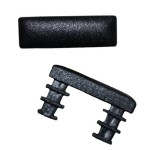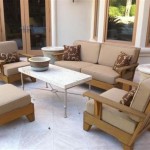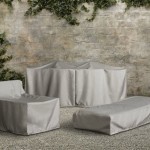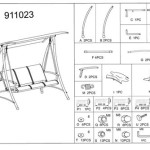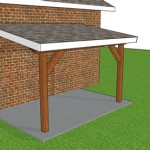Patio Furniture Solutions for Small Backyards
Maximizing the functionality and aesthetic appeal of a small backyard requires careful consideration of patio furniture. Space limitations necessitate strategic planning and selection of items that optimize the available area without compromising comfort or style. This article explores various patio furniture options specifically designed for small backyards, focusing on key considerations for effective space utilization and creating an inviting outdoor environment.
Understanding Spatial Constraints and Design Principles
Before purchasing any patio furniture, understanding the spatial constraints of the backyard is paramount. Accurately measuring the area and creating a scaled drawing or utilizing online design tools can provide a visual representation of the available space. This process helps in identifying potential traffic flow paths and determining optimal furniture placement. Several design principles are particularly relevant for small backyards.
Firstly, employing the principle of verticality can significantly enhance the perceived space. Instead of focusing solely on ground-level furniture, incorporating vertical elements such as wall-mounted planters, tiered shelving units, or hanging chairs can draw the eye upward, creating a sense of spaciousness. These vertical additions also provide opportunities for incorporating greenery and decorative accents without occupying valuable floor space.
Secondly, choosing furniture with clean lines and a minimalist aesthetic can prevent the space from feeling cluttered. Ornate or bulky furniture can visually overwhelm a small backyard. Opting for streamlined designs with simple silhouettes and neutral color palettes can contribute to a more open and airy feel. Materials such as metal, wicker, and lightweight wood are well-suited for creating a modern and uncluttered aesthetic in smaller spaces.
Thirdly, multi-functional furniture is essential for maximizing utility in a limited area. Items that serve multiple purposes, such as storage benches, coffee tables with built-in compartments, or folding chairs, provide practical solutions without adding unnecessary bulk. These pieces allow for efficient use of space and provide convenient storage options for cushions, gardening tools, or other outdoor essentials.
Selecting Appropriate Furniture Types for Small Patio Spaces
The choice of furniture types plays a crucial role in optimizing small patio spaces. Certain types of furniture are inherently better suited for compact areas due to their size, design, and functionality. Careful consideration should be given to the following furniture categories.
Bistro sets, typically consisting of a small round or square table and two chairs, are an excellent option for couples or individuals seeking a cozy outdoor dining area. These sets are compact and easy to move, making them ideal for small balconies, patios, or decks. They provide a comfortable space for enjoying meals or drinks outdoors without occupying significant square footage.
Sectional sofas, while often associated with larger outdoor spaces, can be adapted for smaller backyards by selecting modular configurations. These sectionals can be customized to fit the available area and can be easily reconfigured to accommodate different seating arrangements. Opting for a smaller sectional with a streamlined design and comfortable cushioning can provide ample seating without overwhelming the space. Look for sectionals made from weather-resistant materials such as aluminum or synthetic wicker for durability and low maintenance.
Hanging chairs, also known as egg chairs or swing chairs, offer a unique and space-saving seating solution. These chairs can be suspended from a sturdy frame or from an existing tree branch, eliminating the need for bulky legs or bases. Hanging chairs provide a comfortable and relaxing seating option while adding a touch of whimsy and visual interest to the backyard. They are particularly well-suited for creating a cozy reading nook or relaxation spot.
Folding furniture, including chairs, tables, and benches, is a versatile option for small backyards where space is at a premium. These items can be easily folded and stored when not in use, freeing up valuable space for other activities. Folding furniture is particularly useful for entertaining guests or for creating a flexible outdoor space that can be easily adapted to different needs. Look for folding furniture made from durable and weather-resistant materials such as teak or aluminum.
Outdoor rugs can visually define a seating area and add warmth and texture to a small patio. Choosing a rug that is appropriately sized for the furniture arrangement can help to create a cohesive and inviting outdoor space. Outdoor rugs are available in a variety of materials, colors, and patterns, allowing for personalization and stylistic expression. Look for rugs made from synthetic fibers such as polypropylene or olefin, which are resistant to fading, mold, and mildew.
Material Selection and Durability Considerations
The choice of materials for patio furniture is crucial for ensuring longevity and resistance to the elements. Small backyards are often exposed to varying weather conditions, including sun, rain, and temperature fluctuations. Selecting materials that are specifically designed for outdoor use is essential for maintaining the furniture's appearance and structural integrity.
Aluminum is a popular choice for patio furniture due to its lightweight nature, rust resistance, and durability. Aluminum frames are often used as a base for chairs, tables, and sofas, providing a sturdy and long-lasting foundation. Powder-coated aluminum is particularly resistant to scratches and fading, making it an ideal choice for outdoor use. Aluminum furniture requires minimal maintenance and can be easily cleaned with soap and water.
Wicker, both natural and synthetic, is another common material for patio furniture. Natural wicker is made from plant fibers such as rattan or reed and offers a classic and elegant aesthetic. However, natural wicker is susceptible to damage from moisture and sun exposure and requires regular maintenance to prevent cracking and fading. Synthetic wicker, made from polyethylene or PVC, is a more durable and weather-resistant alternative. Synthetic wicker is designed to mimic the look and feel of natural wicker while offering superior resistance to the elements.
Teak is a hardwood known for its exceptional durability and resistance to decay. Teak furniture is naturally resistant to moisture, insects, and rot, making it an ideal choice for outdoor use. Teak has a rich, golden-brown color that weathers to a silvery-gray patina over time. Teak furniture requires minimal maintenance and can last for decades with proper care. However, teak is a more expensive option compared to other materials.
Outdoor fabrics play a crucial role in the comfort and durability of patio furniture. Fabrics that are specifically designed for outdoor use are resistant to fading, water damage, and mildew. Acrylic fabrics such as Sunbrella are a popular choice for outdoor cushions and upholstery due to their excellent UV resistance and water repellency. These fabrics are also easy to clean and maintain. Polyester fabrics are another option for outdoor cushions and upholstery, offering good durability and resistance to fading. Look for fabrics that are labeled as "outdoor" or "weather-resistant" to ensure their suitability for outdoor use.
Stone or concrete can be used for tables or benches, bringing a natural, grounding element to the space. These materials are incredibly durable and resistant to weather, offering a long-lasting option. However, they can be heavy and difficult to move, making them more suitable for permanent fixtures in the backyard. Proper sealing can help prevent staining and maintain the material's appearance.
Properly caring for patio furniture, regardless of the materials used, is essential for extending its lifespan. Regular cleaning, covering furniture during inclement weather, and storing furniture during the off-season can help to protect it from damage and maintain its appearance. Following the manufacturer's recommendations for cleaning and maintenance can ensure that the furniture remains in good condition for years to come.
In addition to material selection and durability, consider the environmental impact of the furniture. Choosing furniture made from sustainable materials, such as recycled plastic or sustainably harvested wood, can help to reduce the environmental footprint of the outdoor space. Supporting companies that prioritize sustainable manufacturing practices can also contribute to a more environmentally responsible approach to outdoor living.

10 Furniture Sets For Small Spaces Patio
:strip_icc()/100092481-ca052c16890440868979ff49832f94b9.jpg?strip=all)
16 Patio Furniture Ideas To Make Your Backyard A Destination

Patio Furniture Set Outdoor Small Sectional Sofa With Storage Box Pe Rattan Conversation All Weather Gray Wicker Couch Tempered

7 Small Patio Ideas For An Easy Upgrade

10 Small Patio Decor Ideas For Lounging In Style Decorilla Online Interior Design

Top 6 Design Tips Small Backyard Patio Ideas
:strip_icc()/101553364-08234626d7b5450da4e307779037a14f.jpg?strip=all)
16 Patio Furniture Ideas To Make Your Backyard A Destination

Small Backyard Ideas For A Dreamy Outdoor Oasis

Small Patio Decorating Ideas Granite Transformations Blog

Have A Small Outdoor Space And Budget To Match Follow These 7 Rules The New York Times
See Also

